Prologue
For a long time, I dreamed of cycling across the Pyrenees from one coast to the other. In early 2023, I gathered a team of cycling enthusiasts, and we set our trip for May. We rode almost 1000 kilometres in 9 days, crossing the mountains from south to north and reaching 20 summits on our way.
Planning a cycling trip across the Pyrenees was not easy, as I had to research many aspects of the route, such as the starting point (Atlantic or Mediterranean), the route on the Spanish or French side, the weather in May, the daily distance and elevation, and the best lodging and dining options.
If you want to know the answers to these questions and more, read on to find out about my personal experience.

Route summary
You will start your journey in Llança, a quaint village on the Mediterranean coast. The most convenient way to reach it is by flying to Barcelona and then taking a train to Figueres, which takes about three hours. From there, you can cycle the last 20 kilometres to Llança.
After starting your journey in Llança, a coastal town in Catalonia, you will travel along the Spanish side of the Pyrenees, making overnight stops in Ripoll and Sort. Ripoll is a historic town with a Romanesque monastery, while Sort is a lively town known for its adventure sports and lottery shop.
You will then cross the Viehla tunnel, which connects Spain and France under the mountains, and enter the French side of the Hautes-Pyrénées. You will explore the diverse landscapes and culture of this region and eventually reach the Pyrenees National Park, a protected area with stunning scenery and wildlife.
You will also visit Luz Saint Sauveur, a popular ski resort and spa town considered the capital of cyclists in the area. Next, you will return to Spain through the La Piedra de San Martin passage, a historic border crossing that has been used for centuries by pilgrims, smugglers, and soldiers.
You will continue your tour in the Basque country, a region with a distinct identity and culture. You will also visit Pamplona, the capital of Navarre and the host of the famous San Fermin festival. Finally, you will reach San Sebastian, a beautiful city on the Bay of Biscay and the final destination of your tour.
Day 1: Llança – Ripoll
Climbs: ✅ 1/20 Coll de Canes (1120 m)

Start your day with a gentle ride from Llança, a charming village on the Mediterranean coast, to Figueres, the birthplace of the surrealist artist Salvador Dali. You can visit the Dali Museum, which showcases his eccentric and imaginative works. Then, continue your journey to Besalu, a medieval town with a stunning stone bridge and a well-preserved old town. You can stop here for a snack and a stroll around the historic streets.
Next, head to Olot, a city surrounded by volcanoes and natural parks. This is a good place to have lunch, as you will face some uphill challenges afterwards. In Olot, I recommend Nortons bar that serves tasty and cheap food.
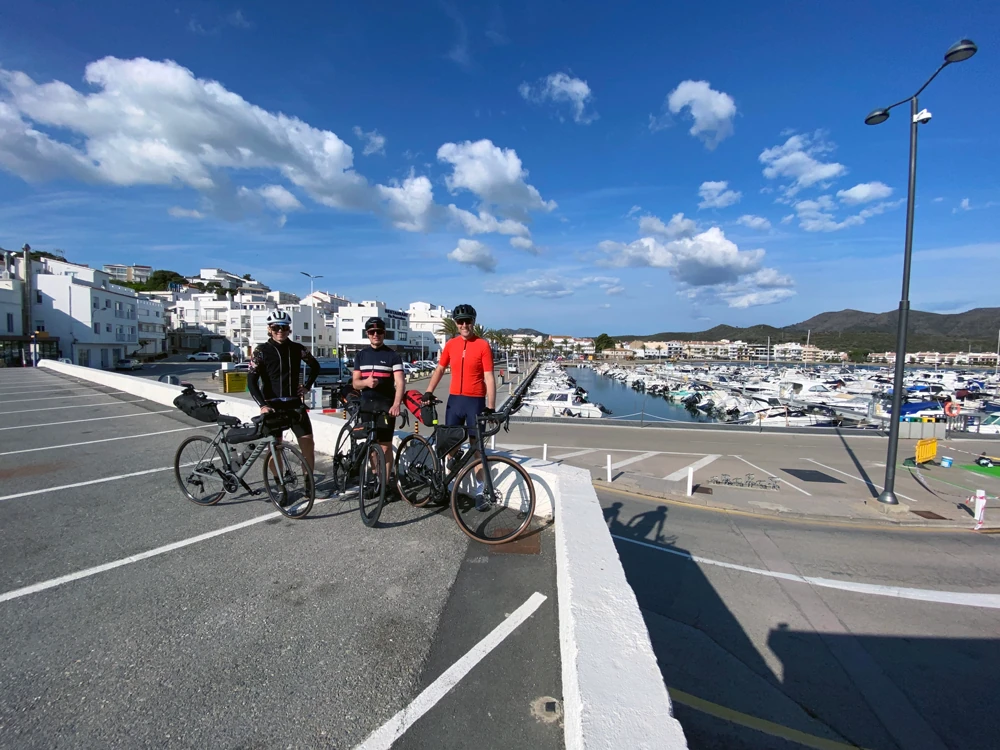

The last part of the route is from Olot to Ripoll, about 40 km. This is the most challenging section, as you will face some steep climbs and descents. You will then reach Coll de Cannes (1120m), your first peak of the tour, where you can enjoy the panoramic views of the Pyrenees.
You will end your day in Ripoll, a town with a rich cultural heritage and a Romanesque monastery. The monastery of Santa Maria de Ripoll is one of the most important examples of Catalan Romanesque art and architecture, and it contains a magnificent portal with sculptures and reliefs.
The first day of the route is relatively short, about 105 km, but it’ll let you feel the rhythm, enjoy the journey, and prepare for upcoming challenges.
Day 2: Ripoll – Sort
Climbs: ✅ 2/20 Coll de Merolla (1099 m) ✅ 3/20 Coll de la Creueta (1921 m) ✅ 4/20 Port del Canto (1721 m)

The second day of the trip is a day of peaks and valleys, as you will cycle through some of the highest and lowest points of the route. You will start from Ripoll and head to Coll de Merolla, a smooth and joyful incline that will warm you up for the rest of the day. You will then follow a lonely and winding road that will take you to La Pobla de Lillet, a picturesque village with a Romanesque church and a modernist garden.
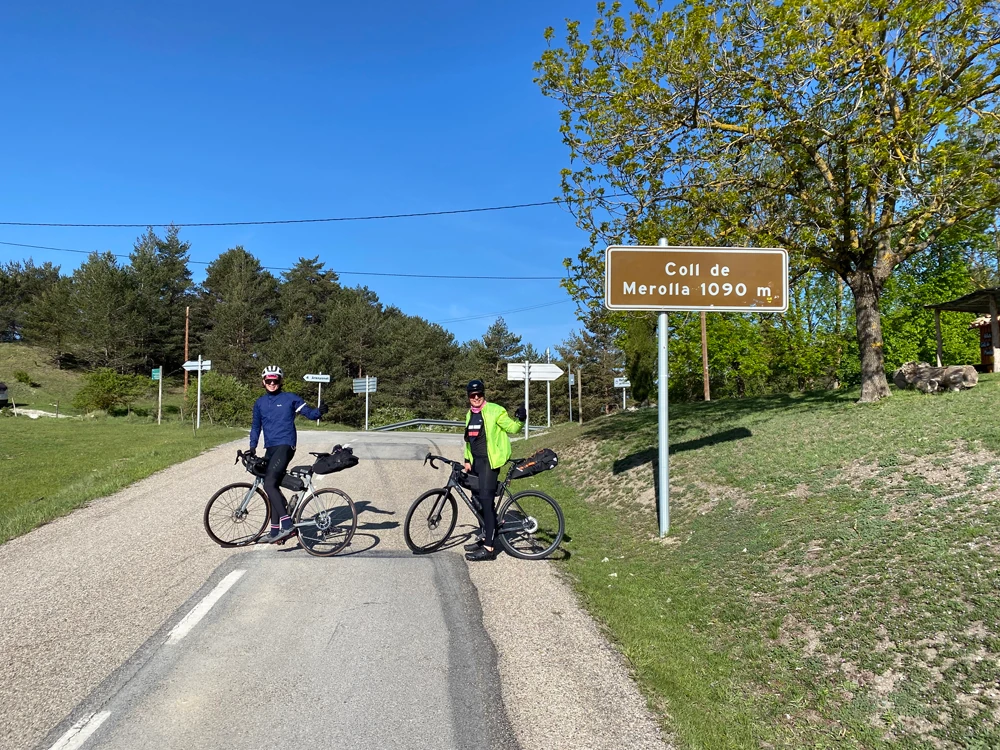

From La Pobla de Lillet, you will face your second and the highest challenge of the day: Coll de la Creueta, a steep and long climb that will test your stamina and skills. You will reach an altitude of 1888m, where you can admire the stunning scenery of the Cerdanya Valley and the Cadí-Moixeró Natural Park. Before reaching the peak, you should stop in Castellar de n’Hug, an excellent tourist place to grab a snack and enjoy the panorama of the Pyrenees.



You will then descend to La Molina, a ski resort. It is an excellent place to have lunch, as there are limited options for eating further on the road.
The next section of the route is from La Molina to La Seu d’Urgell, about 55 km. You will cycle on a bigger road with a little more traffic, but you should not have any issues with that, as drivers highly respect cyclists and the road is wide enough. Moreover, this section is mostly downhill, so you should be able to cover it in less than two hours.
I recommend making another refreshment stop in La Seu d’Urgell, as the most challenging day is still ongoing, and you won’t find a grocery shop later. You will still have another 2nd category climb to Port del Canto. I made a mistake and needed to take more calories. Therefore, I had to suffer until I reached Sort.
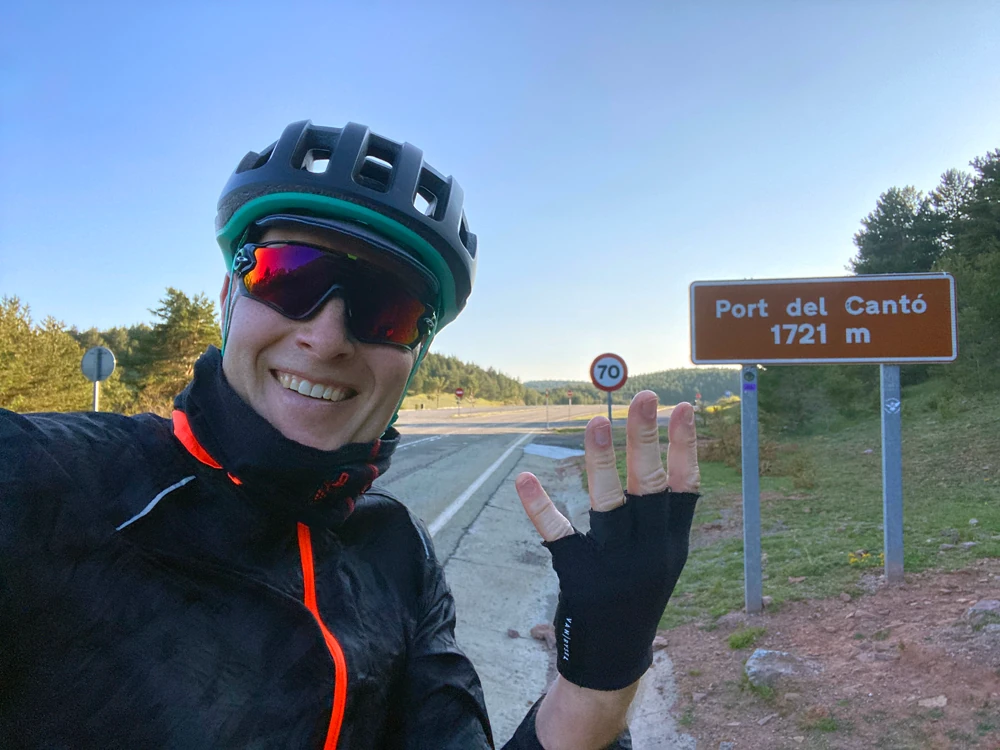

Nevertheless, the descent towards Sort is astonishing. You should enjoy it very much, as you will see some beautiful views of the Noguera Pallaresa River and the Pallars Sobirà region.
The day ends in Sort, a town with a lively atmosphere and many outdoor activities. It is time to grab a pint of beer to celebrate one of the most challenging days of the trip. You should be proud of yourself for making 3000 meters incline in 160 kilometers.
Day 3: Sort – Bossost
Climbs: ✅ 5/20 Coll de Bretui (1056 m) ✅ 6/20 Coll de Perves (1350 m) ✅ 7/20 Tunel de Vielha (1635 m)

The day starts with a 15-kilometre downhill ride along the Noguera Pallaresa River on the main road. After that, you will switch to the country roads of Lerida, a region with a rich heritage and culture. These roads are small and peaceful, as local farmers mainly use them. You will get a glimpse of the rural life and feel the genuine vibe of this area.
Once you conquer the Coll de Bretui peak, you will glide down a short descent until you reach Senterada, and then you will face another ascent to Coll de Perves. The road to El Port de Suert is more lively with motorcyclists and camping vans, as many tourists flock to the nearby Parc Nacional d’Aigüestortes, a stunning natural reserve. You will also marvel at the majestic peaks of the park that loom over the main road.



It would help if you took a lunch break in El Port de Suert, where you can rest and get ready for the challenging Vielha tunnel ascent. We always look for the popular food places with the locals during our day ride. They are usually workers and farmers who come for the daily menu. In El Port de Suert, we found Restaurant La Flor, a simple but nice place to eat.
Climbing the Vielha tunnel slope is relatively easy. You can do it in 3-4 hours. However, the weather can make it a lot more complicated. We had some trouble because of the powerful headwind from the valley and the chilly temperatures. Most of the high peaks in May were still covered with snow, so the temperature plunged from +18 to +7C very quickly. It didn’t rain much, but this place usually has a lot of rainfall. That’s why I recommend you to be ready for the harsh conditions when you take this road.
The Viehla tunnel has a particular crossing procedure that you need to remember. It is longer than 5 kilometers, so cyclists must follow some rules before entering. You need to call SOS and get their permission to enter the tunnel. They will close the lane for cyclists until you finish the distance. The tunnel has a rising road from the Bossost side, so crossing takes more time. That’s why there are two lanes in that direction, and one is only for cyclists until you pass. You must have helmets, lights and safety vests for crossing.
Bossost, the final town in Spain before crossing into France, is where you will end your day tour. You might want to continue the same day, but we decided to stay on the Spanish side for one more night because the accommodation and food prices are much lower in Spain and it is an excellent way to save some euros.
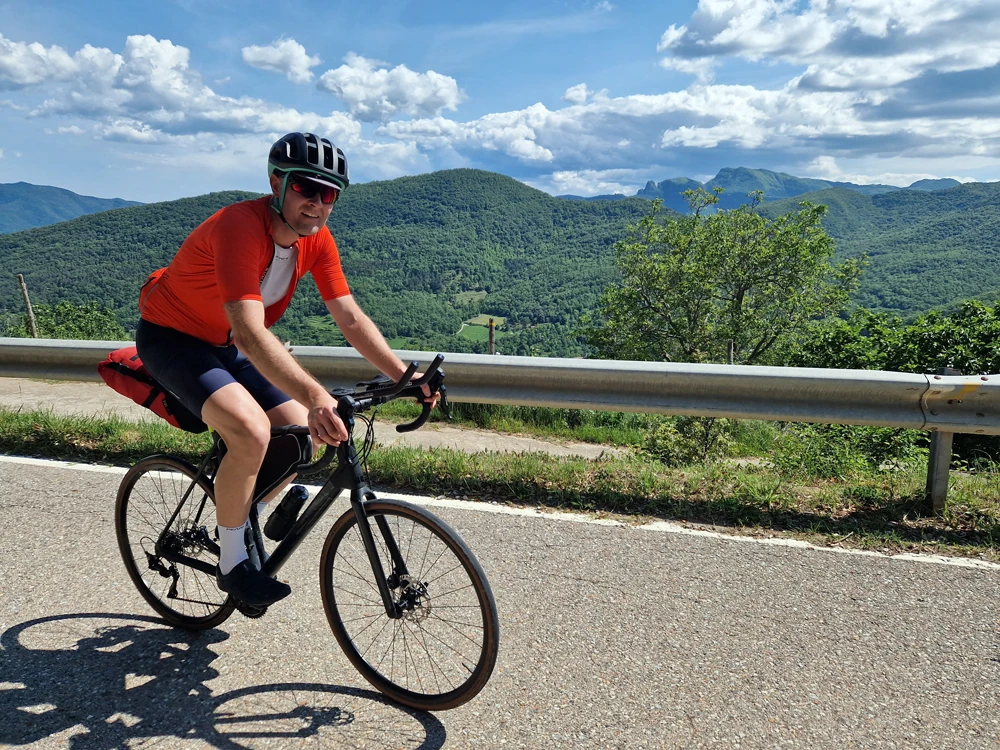


Day 4: Bossost – Campan
Climbs: ✅ 8/20 Col d’Aspin (1489 m)

The route begins with a nice, easy downhill ride towards Loures-Barousse, leaving the highest mountain range. Then, you cycle on the rural part of the region towards La Bather de Neste. On the way, you can enjoy cycling through the hilly and green part of the Pyrenees, which is very different from the Spanish side. You will enter the Pyrenees range again, following La Neste river and cycling until Arreau. Arreau is the town where you will join the original route again.
Our original plan was to cycle from Bossost to Saint Lary Soulan and conquer three famous peaks of Col du Portillo, Col de Peyresourde, and Col d’Azet. But the weather was so terrible in the mountains that we changed our plan, cycled around the mountain range, and reached Arreau at a lower elevation. We avoided some rain, but it was still a damp and cold day. You might prefer our route to make this day easier or if the weather is terrible.
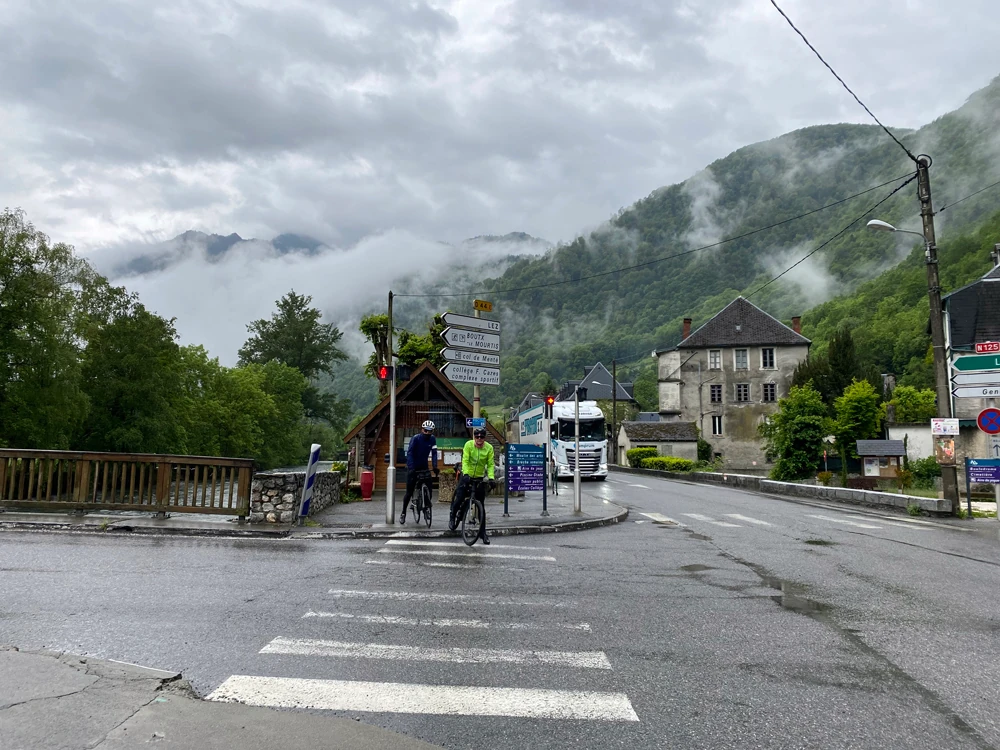


From Arreau, you will start the famous Col d’Aspin ascent featured in the Tour de France 71 times. If you are not aiming to compete with the best riders, take some time to enjoy the scenery because it becomes more impressive and stunning with every 100 meters. Another good thing about this ascent is the road quality. Because of its popularity in the Tour de France, it is always maintained in excellent condition.
The last section of the day is a beautiful downhill ride towards Sainte-Marie-de-Campan, where you can stay for the night and enjoy the scenery between two famous Cols – Col d’Aspin and Col du Tourmalet. You will face Col du Tourmalet the next day.
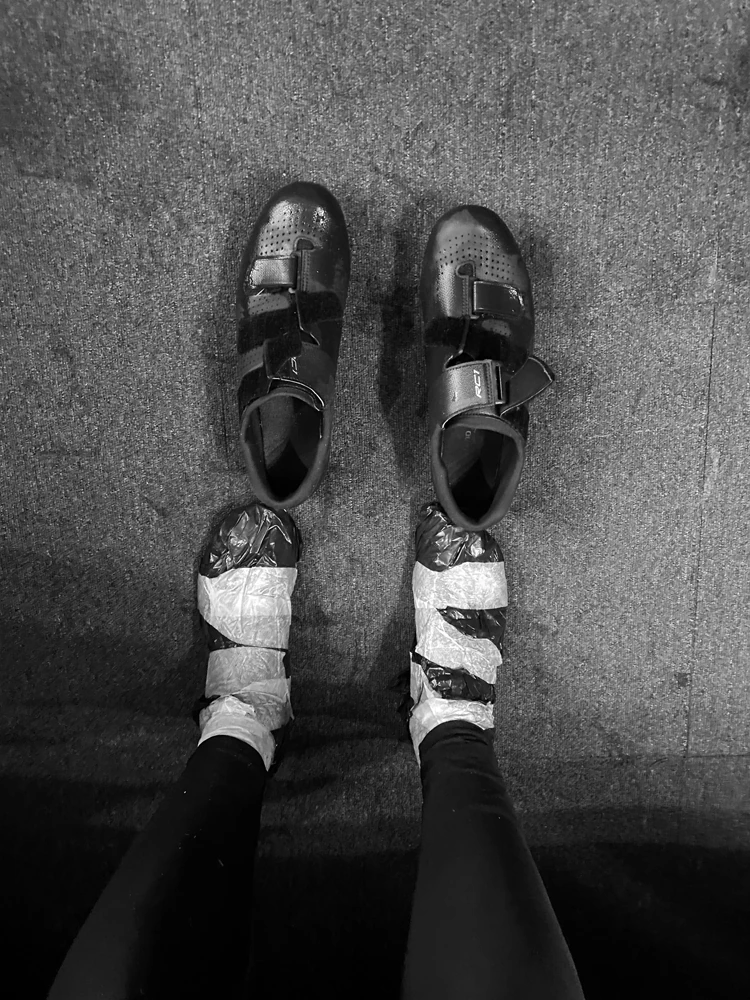



Day 5: Campan – Luz Saint Sauveur
Climbs: ✅ 9/20 Col du Tourmalet (2115 m) ✅ 10/20 Luz-Ardiden (1718 m)

This is a short day in terms of distance. I did it on purpose for two reasons. First, after several harrowing days, reducing the load for a while is good. Rather than taking a rest day, I like short half-day rides that don’t disrupt the balance too much. The second reason Luz Saint Sauveur is a well-known resort for cyclists. It is a great chance to stay longer and enjoy the town’s atmosphere. If you feel good, cycle some surrounding peaks without luggage.



Before enjoying the relaxation in Luz Saint Sauveur, you must face the challenge of cycling up to Col du Tourmalet and crossing the mountain to the other side. The first 5 kilometers are a gentle warm-up with a 4% gradient, but after you reach 1000 m altitude, it becomes steeper at 8%. You should conserve your energy initially because you have a long way to go. The weather is another factor that affects your performance.
We were lucky to have a temperature of about +15C and a wet road from the previous day. It was ideal for climbing up. When the sky is clear, you can also admire the view of the valley below or the snowy peaks near the La Mongie ski resort.
I would recommend trying Col du Tourmalet in early June because the final kilometer was still full of snow, and the road was not open for cars. But if you have a fixed schedule, you can also manage it in May, as long as you have suitable clothes.
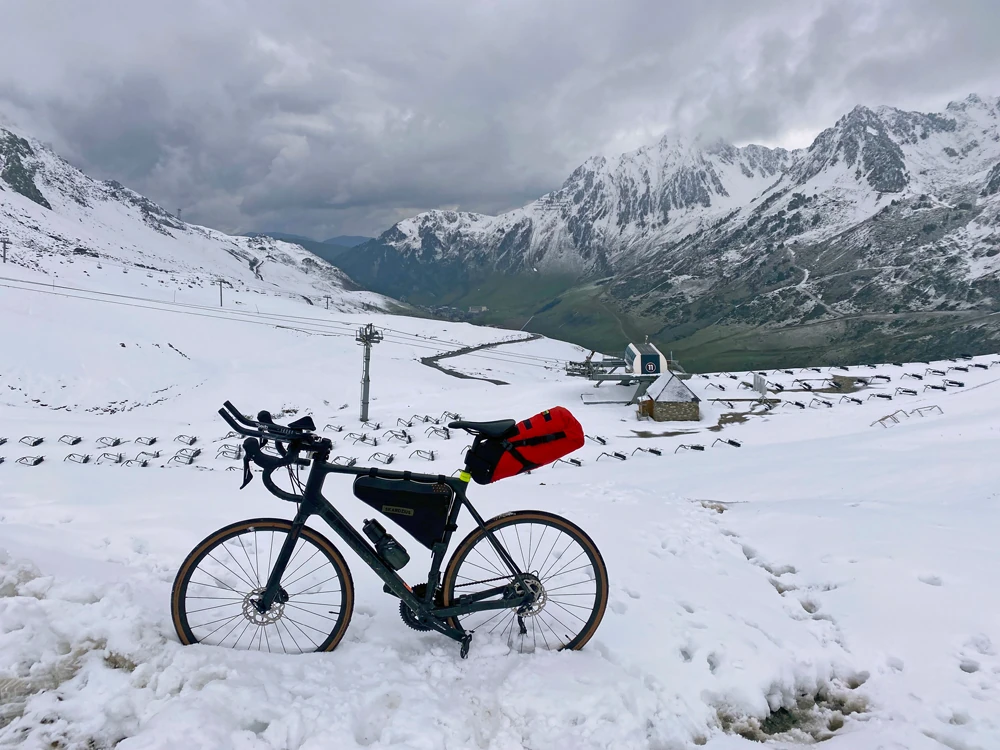



Arriving at Luz Saint Sauveur by noon, you can rest or visit other peaks. I chose to cycle more. Some of the peaks I could see were Hautacam, Plateau de Saugué, Barrage des Gloriettes and Luz-Ardiden. I left my bikepack and tried to ride up to Luz-Ardiden. It was a remarkable climb with a beautiful, curvy road. It seemed like I had climbed a wall from the top, but the road was not too steep. The round trip took me 2.5 hours and was one of the best climbs I have ever done.
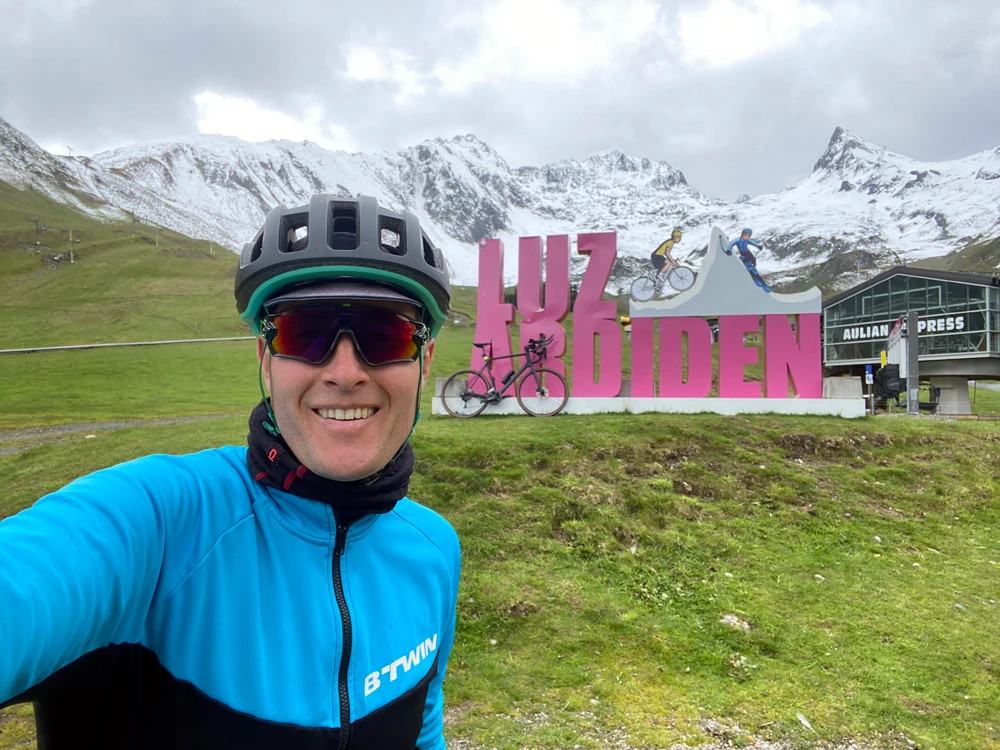



Relax your evening wandering around the town and exploring local bicycle shops and dining places. It is a beautiful place that exudes cycling culture everywhere.
Day 6: Luz Saint Sauveur – Arudy
Climbs: ✅ 11/20 Col du Soulor (1474 m) ✅ 12/20 Col d’Aubisque (1709 m)

The next morning, you will begin your day with a speedy ride to the picturesque Argelès-Gazost valley. Located at the confluence of the rivers, which are locally known as the gaves, at an elevation of 460 m, Argelès-Gazost is a strategic gateway in the Hautes-Pyrénées.
From there, you will head towards the majestic Col du Soulor peak, but before that, you will enjoy a scenic ride of 20 kilometres on the charming country roads. Instead of taking the busy main road, follow my recommended route, passing through quaint villages dotted with French summerhouses. We cycled on a sunny Sunday, and the area was still lively, with young families having fun on a warm spring day in the Hautes-Pyrénées.
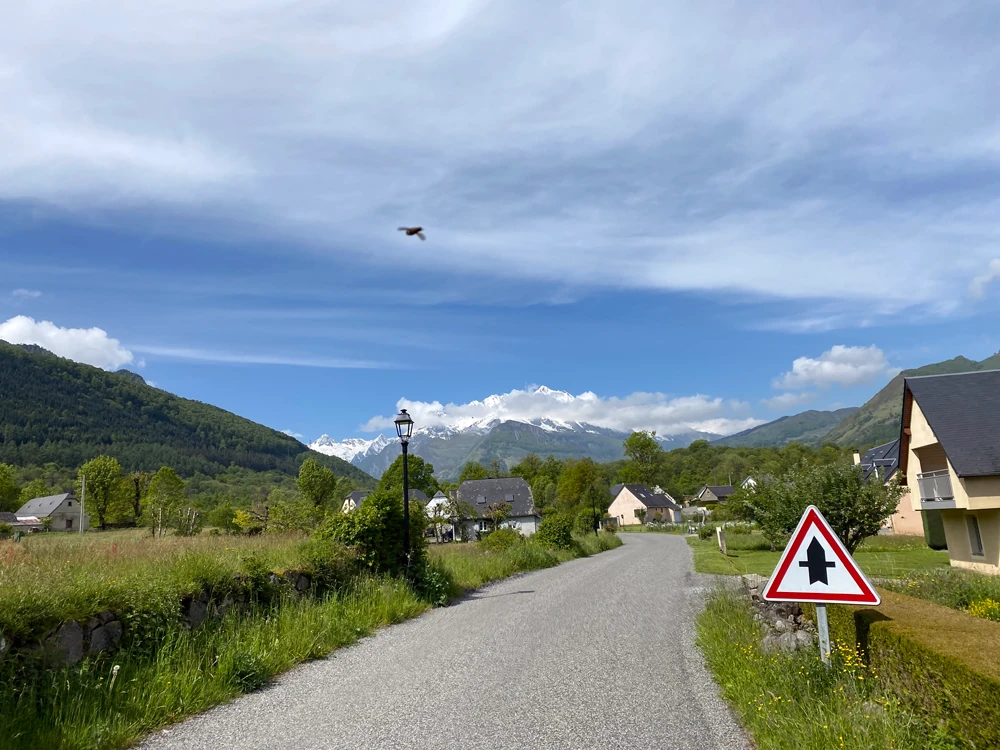


Don’t miss the opportunity to stop by the only grocery shop in Arrens because the next one is in Laruns only. To get there, you must conquer two challenging peaks in succession.
Like all the climbs featured on the Tour de France, Col du Soulor has a smooth and well-maintained road. There are also informative signs after every kilometre that give you details on what to expect around the corner. It is a splendid introduction before reaching Col d’Aubisque.
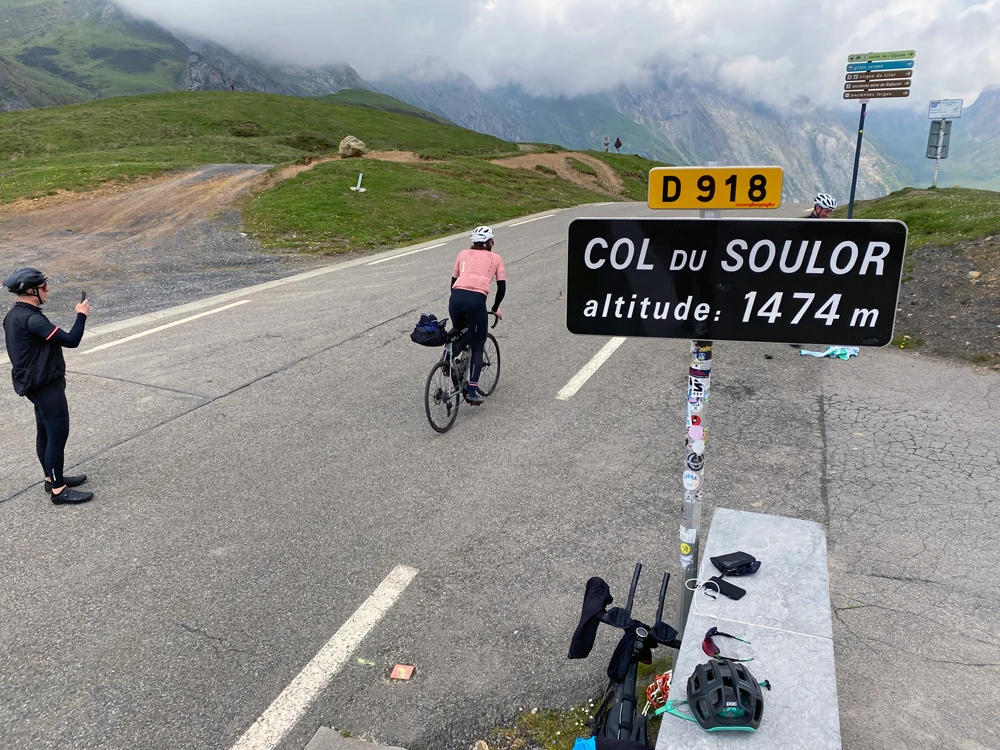


The road from Col du Soulor to Col d’Aubisique is narrower and only accessible by motorbikes and regular cars. During our visit in June, it was still closed, and only bicycles could pass through, so you don’t have to worry about the traffic. The scenery is very stunning. With a slight descent, you will pass a few mountain tunnels and start climbing again to the summit.
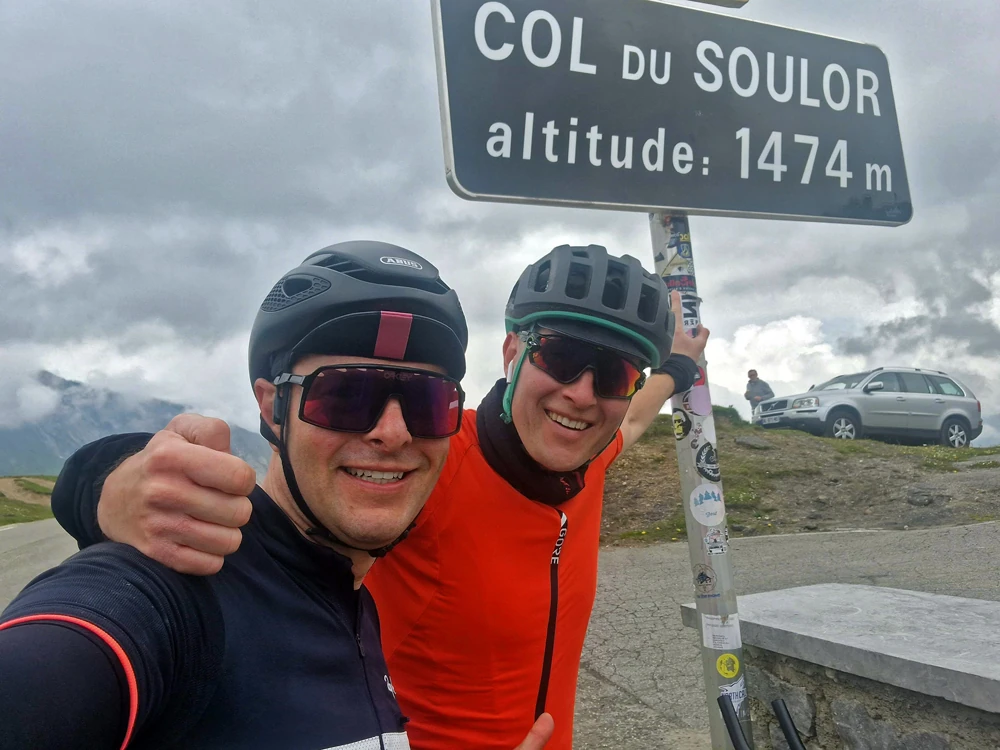


Take a break at Col d’Aubisique. I recommend visiting the Restaurant bar du col d’aubisque, which is full of Tour de France history. There are many photos and accessories that commemorate cycling in the early 20th century. Outside is a monument for Lucien Buysse, who won the Tour de France in 1926 and giant bicycle sculptures representing the greatness of Le Tour.
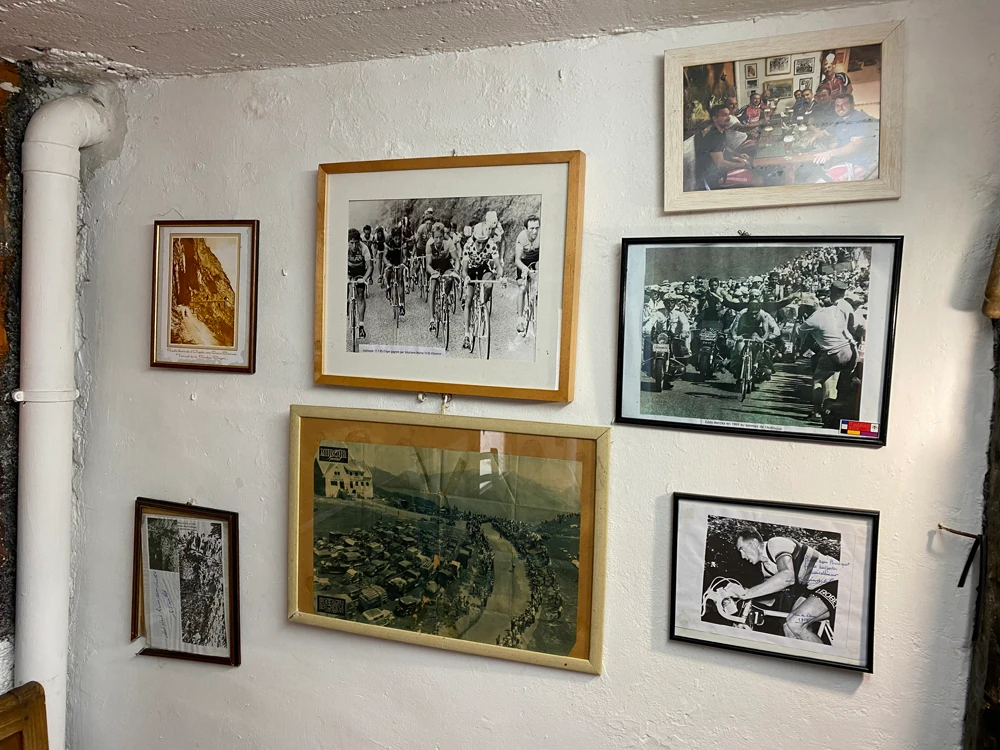


The final stretch of the day will be a breeze. You will arrive at Laruns after passing by some ski resorts and then cycling on the bike path along the river Gave d’Ossau until you reach Arudy. We have opted to stay in Arudy only for practical reasons. There were simply no other budget-friendly accommodation options in the vicinity. Apart from that, Arudy is just an ordinary small town without memorable tourist attractions. If you spot better lodging options nearby, feel free to skip Arudy.
Day 7: Arudy – Isaba
Climbs: ✅ 13/20 Col de Marie Blanque (1035 m) ✅ 14/20 Col d’Ichere (675 m) ✅ 15/20 Col de Lie (601 m) ✅ 16/20 Col de la Pierre Saint-Martin (1768 m)

You will enter the Basque region on the seventh day. Before enjoying the Basque scenery, you must cross the La Piedra de San Martin pass. The day begins with an easy ascent to Col de Marie Blanque, followed by two smaller climbs to 680 meters (Col d’Ichere and Col de Lie). They may look simple at first glance, but don’t be fooled. The road from Escot to Arette passes through isolated villages with sharp slopes. It is harder than it appears.
Another French region you will see is Pyrénées-Atlantiques. The living there is unforgettable, with green hills dotted with small villages, farms and stables.
Stop for lunch in Arette. Bar Restaurant Gouaillardeu has a great day menu and homemade wine. Try their food and drinks to boost your mood and energy. You will need them for the challenging Col de Pierre Saint Martin climb.
Col de la Pierre Saint-Martin is an excellent climb for cyclists who love a challenge and a scenic view. It begins from Arette village and goes up 25.4 km with a 5.7% average slope and a 15% peak. The Tour de France used this climb twice, the last time in 2015 when Chris Froome won. Cyclists can cross from France to Spain at the summit. Despite the wind and rain, we reached the top from Arette in 3 hours.
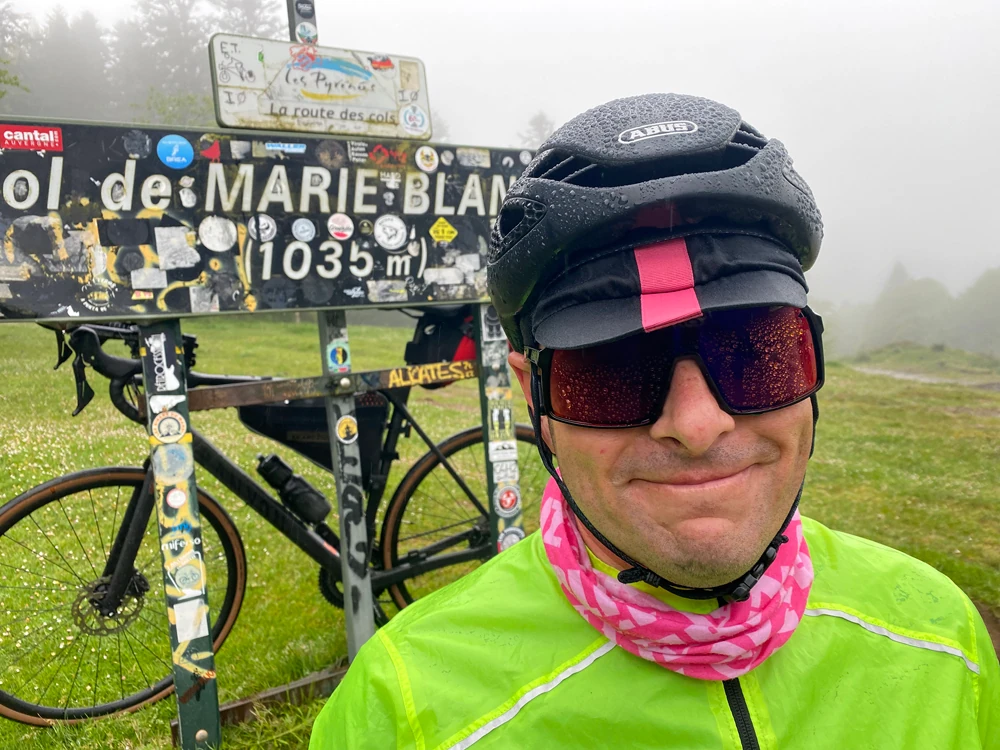



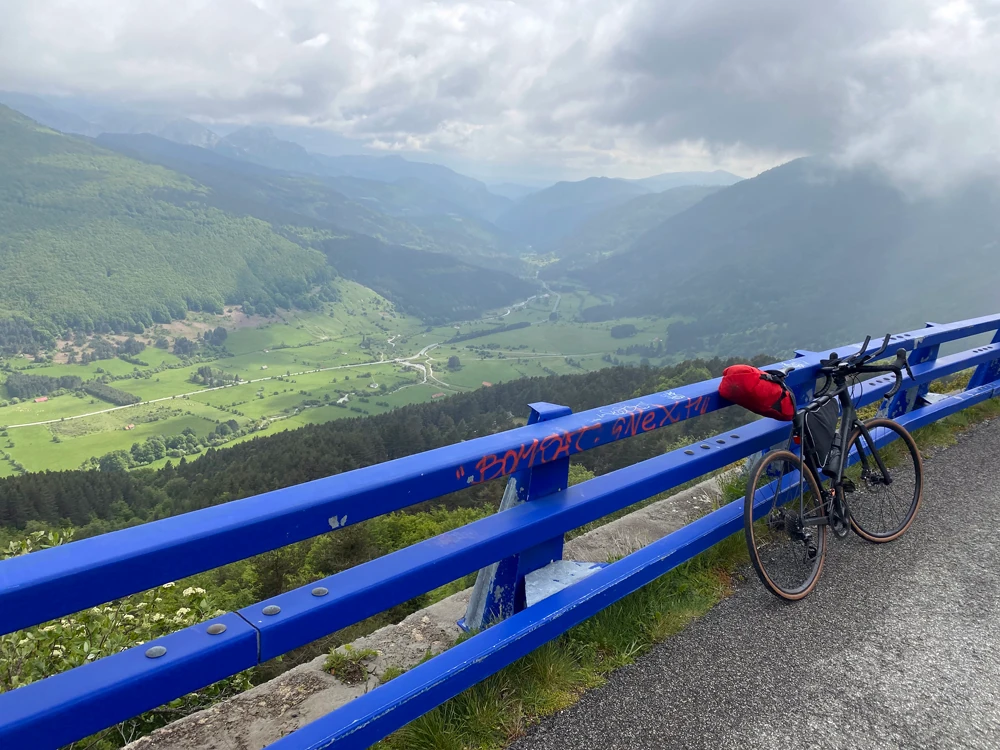

Day 8: Isaba – Pamplona
Climbs: ✅ 17/20 Alto Laza (1107 m) ✅ 18/20 Remendia (1040 m) ✅ 19/20 Abaurregaina (1052 m) ✅ 20/20 Alto de Erro (801 m)

Start your day in the charming town of Isaba, nestled in the heart of the Western Pyrenees. From there, you will follow the winding roads that lead you through quaint basque villages along the border with France. You will be mesmerized by the stunning views of the green pine forests that cover the mountains.
After pedalling for an hour, you will reach the highest peak of the day: Alto Laza, a pleasurable climb that will take you to the highest point of your route today.
This is where you will say goodbye to the mountain range. Later, there will still be a few inclines on the way, but you will mostly descend towards Pamplona.
On your way down, you will encounter some of the most picturesque villages in the region, such as Izalzu and Ezcároz, where you can admire their unique architecture and culture. Don’t miss the opportunity to visit the Iglesia de El Salvador church in Jaurrieta, a beautiful example of Romanesque art.
Treat yourself to some delicious grilled food for lunch at Herriko Etxea, a cosy and affordable restaurant in Garralda. You can relax and enjoy your meal, knowing that the rest of your journey will be easy and smooth. You have only 50 kilometres left to reach Pamplona.
By the early afternoon, you will arrive in Pamplona, a beautiful city with a rich history and a symbolic significance for pilgrims. You can explore the old town, where many churches and monuments reflect the region’s diverse cultural influences. Some of the highlights are the Cathedral of Royal Saint Mary, a Gothic masterpiece with a neoclassical façade, and the Citadel of Pamplona, a 16th-century fortress that is now a public park. You can also enjoy the lively atmosphere of the streets and squares, where you can taste some of the local cuisine and wine.




Day 9: Pamplona – San Sebastian

For your last tour day, you will leave Pamplona on the Eurovelo 1 route. You will stay on this route only until you leave the city. Then, you will avoid it because it has many unpaved parts that are better for walking pilgrims. You will face some road traffic until you reach Irurtzun. After that, you will cycle on the peaceful rural roads that local drivers mostly use. The last part of San Sebastian will be busier as you enter the urban area of Gipuzkoa province. Probably, you may find some quieter cycling paths to the Atlantic coast than ours. But we chose the shortest one to finish our tour as soon as possible.
Your adventure concludes at the Pasealeku Berria balcón place, where you can pop the champagne to celebrate your successful trip. You have completed an enchanting and demanding journey, giving you new vivid memories for your future.
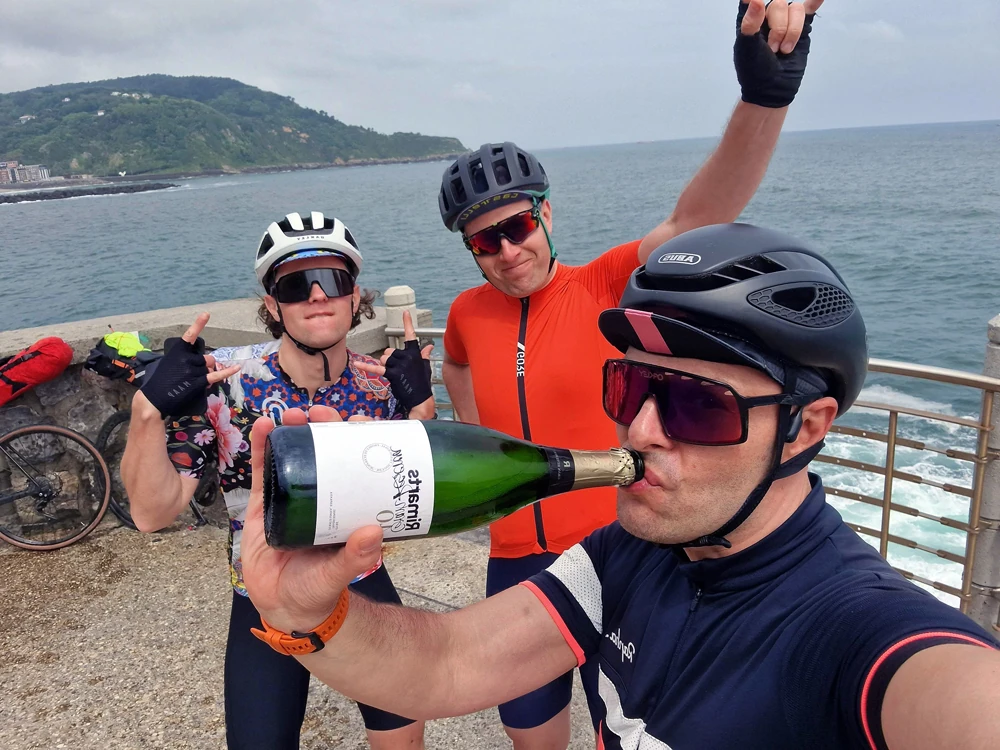


Conclusion and FAQ
Every advanced cyclist should experience the thrill of crossing the Pyrenees. Along the journey, you can witness the diverse landscapes of the Pyrenees and learn about the customs and cultures of various regions in Spain and France. It is a rewarding challenge that requires proper preparation and planning.
Here is how I would answer today the questions raised before the ride:
1. What is the best direction to cycle across the Pyrenees mountains?
Some cyclists prefer to start from the Atlantic coast and take advantage of the North and North West winds from the ocean. However, we did the opposite and did not encounter any issues. I believe that the direction is not very important, and you can choose it based on your convenience and schedule.
2. Which side of the Pyrenees should you choose: French or Spanish?
Both sides have their own charms and challenges. The Spanish side has a more arid and wild landscape, while the French side has a more verdant and populated landscape. The cultural diversity of the Pyrenees is also worth exploring, as you can visit different regions with their own languages, traditions and cuisines. A good way to enjoy both sides is to divide your tour into two halves, spending some days in Spain and some days in France.
3. What kind of weather should we expect in May when crossing the peaks?
The weather in the Pyrenees in May can vary greatly depending on which side and which region you are crossing. In general, you can expect mild to warm temperatures, but also some rain and snow at higher altitudes. It is the begining of the cycling season and you should have warmer apparel as well as summer gear.
4. What is a good daily distance and elevation for amateur cyclists in the Pyrenees?
Based on our experience, I think the best range is between 120 and 140 km per day, with an average of 2500 m of ascent per day
5. Where can you find good lodging and dining options on the route?
We liked these places for sleeping: Hotel Restaurant Les Brases, HostalTina, Hôtel les Deux Cols, Hotel y Apartamentos SNÖ Isaba
I suggest these places for eating: Nortons bar, Restaurant La Flor, Bar Restaurant Gouaillardeu, Herriko Etxea, Cervecerías La Mejillonera
Thanks for reading!





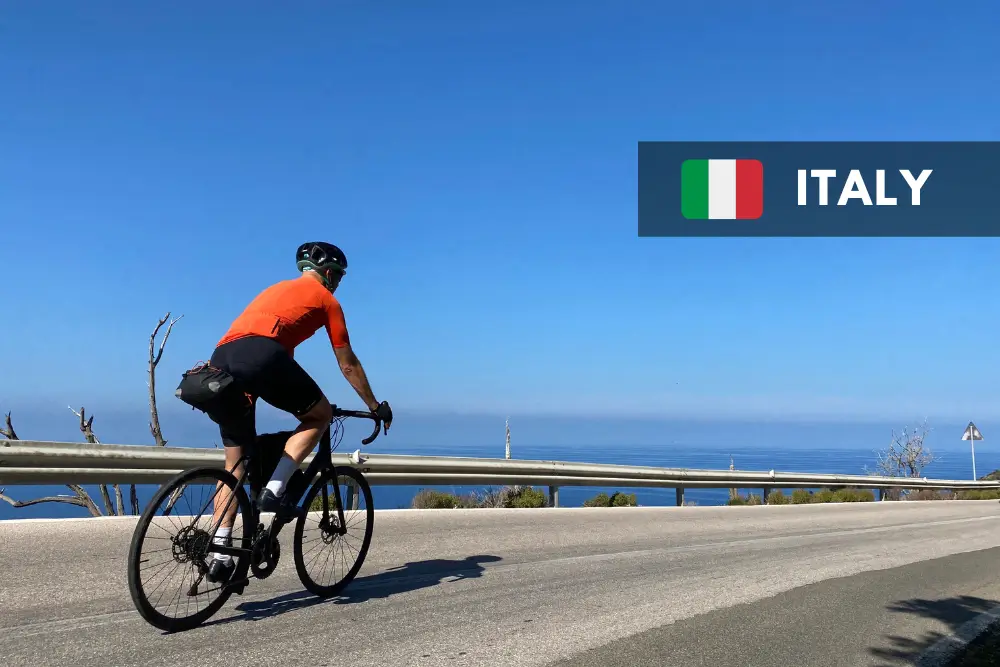


0 Comments